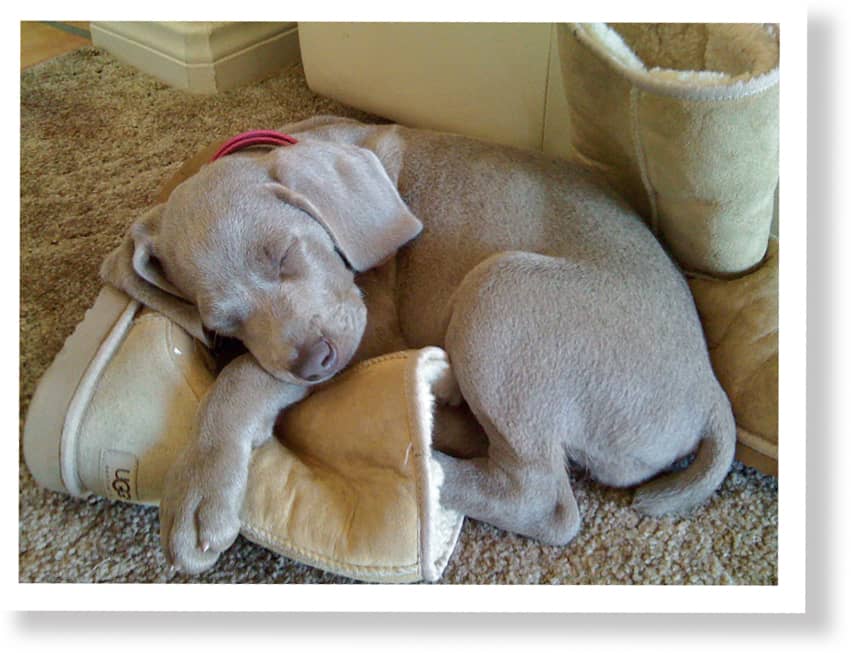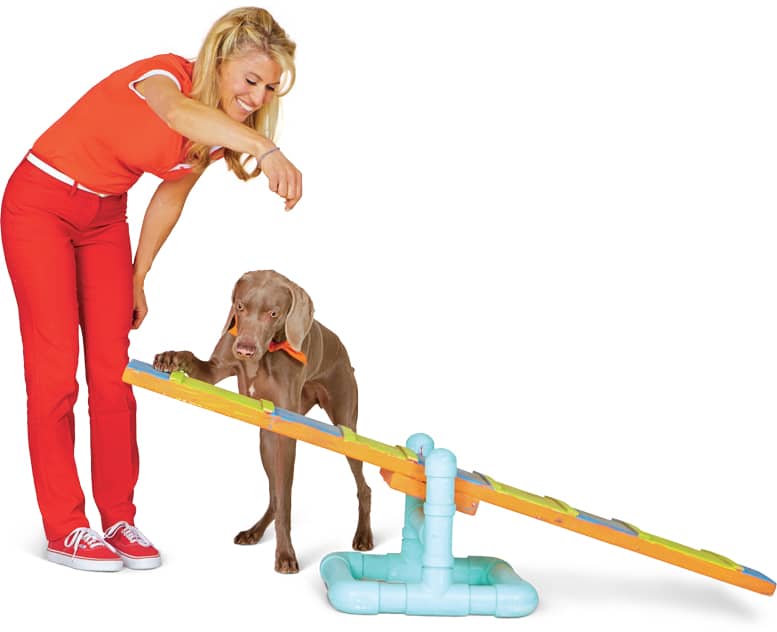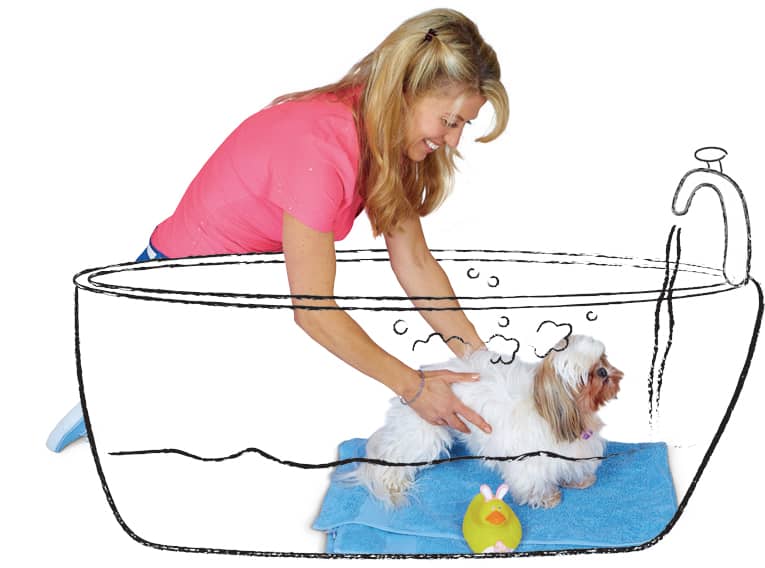Chapter 9
Getting Braver: Overcoming Common Fears

Courage can be learned. There are two science-based methods that we can use to gradually change our dogs’ perception of a situation from one of fear to one of ambivilence or even excitement and joy. The steps in this chapter will walk you through the incremental process of overcoming your dog’s fear.
Positive redirection is the distracting of your dog from the feared object by encouraging him into a more rewarding situation. Instead of leaving him to stress about being home alone, we give him a food toy to struggle with.
Counterconditioning is the process of exposing your dog to a low level of the feared object, and then pairing the onset of that object with yummy food. It’s almost like the object predicts a yummy food treat.
Notice how one or both of these methods are being used in every skill in this chapter.


Increase Confidence with a Home-Base Pedestal
TEACH IT:

Pedestal training is a strategy used to increase confidence in dogs and puppies. Dogs are naturally height-seeking, and this advantage makes them feel more confident. A pedestal acts as a “home base” for your dog, giving him a default, secure place to be. Teach your dog to get on the pedestal.
1 Hold several treats at your dog’s nose. Tell her “step up” and slowly move your hand up over the pedestal, luring her nose to follow it. Give her little treats along the way to keep her motivated but continue to lure her farther and farther onto the pedestal.
2 When your dog makes it all the way onto the pedestal, give her treats and praise and petting. Make the pedestal a super-rewarding place to be.
3 When your dog is on the pedestal, she is in an implied “stay.” She should not be allowed to jump off of it at will; rather only when you ask her to. Say “Off” and pat your leg or the back of her neck to cue her dismount.
4 As she improves, see if you can send her to “step up” from farther away. Continue to use an arm sweep signal that is similar to the initial luring motion that she was taught with. Give a treat while she is on the pedestal.
WHAT TO EXPECT: If you make the pedestal a rewarding place to be (with treats and petting) your dog will take to it very quickly, and you’ll likely find her jumping on her pedestal without having been asked!
STEPS:

1 Use several small treats to lure your dog onto the pedestal.

2 Give her treats and petting on top.

3 Cue “off” to dismount.

4 Send her to “step up” with an arm sweep.
Fear of an Object

TEACH IT:
For a dog to overcome his fear of an object, he must approach it on his own. Coax him to do so by playing the “bull’s-eye game;” place treats closer and closer to the object.
1 Place a treat a far distance from the feared object. You want to get your dog excited about the game, so she needs to have zero fear when getting the first few treats.
2 Let your dog get the treat.
3 Continue to place treats closer and closer to the bull’s-eye.
4 Your dog will cautiously take the treat and then most likely run back to you. Give her another treat when she does.
5 If at any time your dog stops progressing, regress back to an easier distance.
6 Step by step, your dog will gain confidence and conquer her fear.
WHAT TO EXPECT: The process of counter-conditioning (pairing a good thing with the feared thing) has many periods of regression. This step backward is usually only needed for a short while and will give them the momentum to push forward again.
STEPS:

1 Place a treat a far distance from the object.

2 Let your dog get the treat.

3 Place treats closer to the bull’s-eye.

4 Give your dog a treat every time she successfully gets a treat from the ground.

5 If your dog stalls, regress back to an easier step.

6 With baby steps, your dog will conquer her fear!
Fear of Loud Sounds

TEACH IT:
Is your dog afraid of thunder, fireworks, and loud sounds? Use the process of counterconditioning to pair a yummy treat with the scary sound. Use the “bang game” to let your dog initiate the loud sound.
1 Hold the board down with your foot. Use a treat to lure your dog to step on the board.
2 When she does, let her have the treat.
3 Next time, hold the board an inch (2.5 cm) off the ground and lure her to step on it.
4 Let the board drop to the ground. The sound will startle her. The instant you hear the sound, pop a treat in her mouth.
5 Keep pairing the food reward with the bang sound, and eventually your dog will be banging with gusto!
WHAT TO EXPECT: Counterconditioning is the most effective method of reducing a fear. Don’t rush progress, as you want to keep the sound below your dog’s fear threshold.
STEPS:

1 Use a treat to lure your dog onto the board.

2 When she does, give her the treat.

3 This time, hold the board an inch (2.5 cm)off the ground.

4 The instant the board drops and makes a sound, give her the treat.

5 Eventually your dog will be slamming that board!
Fear of Being Left Alone

TEACH IT:
Many dogs suffer from separation anxiety when their owner leaves. This can manifest as whining and barking, destroying furniture, relieving themselves in the house, or obsessive behaviors. Help your dog break this pattern of anxious behavior by giving her something else to focus on.
1 Before you leave, hide treats all around the house.
2 Your dog will be entertained and distracted while you are out.
3 When you leave, don’t make a big deal of it. Hand your dog a peanut butter-stuffed Kong or food-dispensing toy to keep her busy while you make your exit.
4 At first, practice returning home after just a few minutes. Don’t make a big deal with your entrance; keep it low key.
WHAT TO EXPECT: Separation anxiety is a difficult condition to remedy. Improvements will be small and slow, but take comfort in knowing that with every small step, it WILL get better.
STEPS:

1 Hide treats around the house.

2 Your dog will be busy searching for treats.

3 Distract your dog with a peanut butter Kong while you make a subtle exit.

4 After a few minutes, return home. Keep it low-key.
Fear of Some People
TEACH IT:
Dogs can have fears of different types of people, including fear of men, children, people in hats or hoods, people in uniform, people in wetsuits or snowsuits or dark clothes, etc. Help your dog overcome her fear by showing her that these people carry treats!
1 Hang out in front of the supermarket and recruit a person whom you think your dog will be afraid of. Give that person a handful of treats.
2 Have the stranger kneel down, turn away, and simply DROP a treat on the ground.
3 After a few successes, see if your dog will take a treat from his hand.
4 Have the stranger face your dog but not make eye contact as he offers more treats.
5 Stand up … more treats.
6 By this time, your dog will be pretty pleased with her new buddy! Repeat this exercise a dozen times.
WHAT TO EXPECT: The more new people your dog is able to take treats from, the more rapidly his confidence with people will accelerate. Carry treats with you whenever you have your dog, so you can practice often.

STEPS:

1 Give a handful of yummy treats to a stranger.

2 Have him drop treats on the ground.

3 Can your dog take a treat from his hand?

4 The stranger should avoid eye contact.

5 Continue to give treats while standing a bit taller.

6 Your dog has a new buddy!
Fear of Other Dogs
TEACH IT:
When your dog sees another dog, does he tremble or hug against your leg? Does he snap at the other dog to scare him away? Help your dog make friends with these strategies.
1 Take both dogs on a walk. This will allow them to bond as a pack, without asking them to directly interact.
2 Sit between the two dogs and play with a squeak toy. This again will allow them to be in the same space but focused on something other than each other. It will also give your dog confidence to have you in control of the situation.
3 Present two biscuits to the dogs at the same time. This gives your dog a pleasant association between being near the new dog and getting a treat. Give the treats at the same time to avoid jealousy.
4 Is your dog nervous? Have him do a trick to get him to focus on you, while allowing him to be in the presence of the new dog.
WHAT TO EXPECT: The more successful encounters your dog has with new dogs, the easier it will be for him to make new friends.

STEPS:

1 Take both dogs on a walk.

2 Sit between them with a squeaky toy.

3 Present two biscuits at the same time.

4 Have your dog do tricks in the presence of the other dog.
Fear of Vacuum Cleaner
TEACH IT:
Does just wheeling the vacuum cleaner out of the closet cause your dog to run for cover? Does she bark and snap at this monster? Help your dog make peace with this enemy.
1 Desensitize your dog to the vacuum cleaner; leave it in the room. Turn it on for a second and off again.
2 Vacuum with your back to your dog, pushing the vacuum cleaner away from—not toward—your dog.
3 Your dog will have more confidence if she is high up, on a chair.
4 Give your dog a peanut butter-filled Kong toy or a chew stick to work on while you vacuum. This will help acclimate her to being in the same room with the machine.
WHAT TO EXPECT: Dogs can absolutely become accustomed to the vacuum cleaner. By making the effort to get your dog used to it, you are helping her become a more confident dog with less general anxiety.

STEPS:

1 Turn the vacuum cleaner on and off again.

2 Push the vacuum cleaner AWAY from your dog.

3 Your dog will have more confidence if she is high up.

4 Give your dog a peanut butter-filled Kong or chew stick.
Fear of Slippery Floors
TEACH IT:
Is your dog afraid to walk through the kitchen? Up the stairs? Across the linoleum floor at the vet’s office? Help her overcome this fear of slippery floors.
1 Put a treat in a dog bowl (as it is large and visual) at the edge of the slippery floor. Let your dog go get it.
2 Use bath mats to make a pathway to the food bowl. Walk next to your dog as she makes the journey.
3 Start to add some gaps between the bath mats that your dog will have to navigate over.
4 Enthusiastic praise will go a long way in encouraging your dog.
WHAT TO EXPECT: Using this method, dogs can usually start walking on a slippery floor within a day or two.

STEPS:

1 Put a treat in a bowl at the edge of the floor. Let your dog get it.

2 Make a walkway of bath mats to the bowl.

3 Start to separate the bath mats.

4 Lots of praise will accelerate the process.
Fear of Bathtub
TEACH IT:
Does your dog cower when you say the word “bath”? Does he freeze up when his nails hit the porcelain of the tub? Make bathtime easier with these simple steps.
1 Place a towel in the empty, dry tub to give your dog secure footing. Toss a treat in there, and encourage him to jump in after it. Repeat this several times.
2 Run a trickle of water with the drain open.
3 Gradually let the water level rise with your dog in the tub. Distract him with sudsing up.
4 Giving treats during the bath never hurts. Some dogs will be too anxious to eat the treats, which is normal.
WHAT TO EXPECT: Few dogs ever really LIKE baths, but by approaching it in a gentle, slow manner we can avoid a chaotic scene and get through the chore smoothly.

STEPS:

1 Place a towel in the dry tub. Encourage your dog to get the treats.

2 Run a trickle of water with the drain open.

3 Let the water level rise as you suds him up.

4 Offer your dog treats (although he may not take them).